You’ve probably noticed jewelry prices climbing while environmental concerns grow louder. What if you could address both issues simultaneously? Recycled metals offer an unexpected solution that’s transforming how artisans create stunning pieces. When you understand which scrap materials work best and master the essential techniques, you’ll discover that yesterday’s discarded metal becomes tomorrow’s heirloom. The process isn’t as complicated as you might think, but there’s one vital step most beginners overlook.
Understanding Eco-Friendly Recycled Metals in Jewelry Making
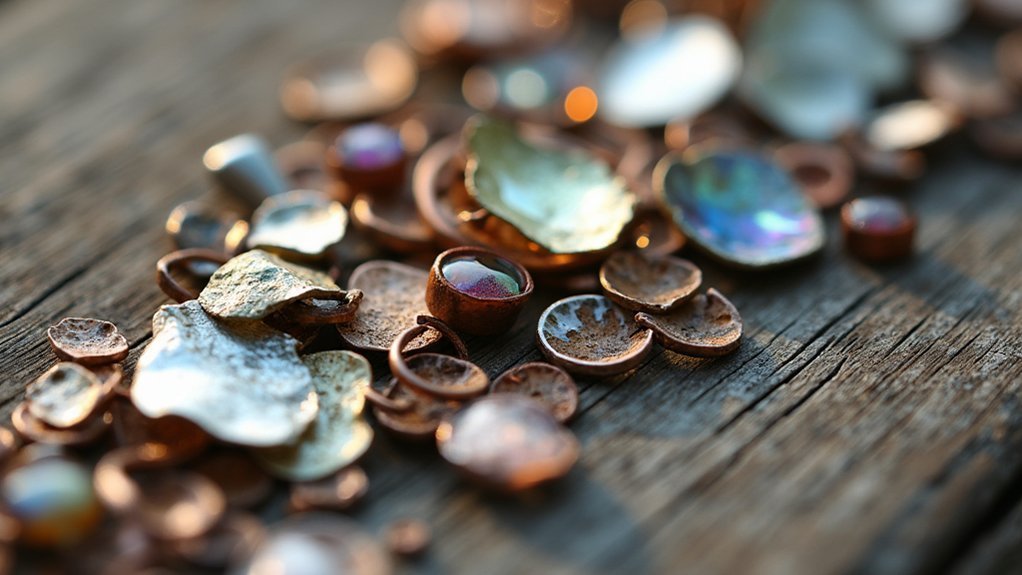
When you choose recycled metals for your jewelry, you’re making a powerful environmental statement that goes far beyond aesthetics.
Selecting recycled metals transforms your jewelry into a meaningful statement of environmental responsibility and conscious consumer choice.
These sustainable jewelry materials come from old coins, broken pieces, and industrial scrap that would otherwise end up in landfills. By selecting recycled gold, silver, and copper, you’re dramatically reducing environmental impact—considering that extracting one gold ring generates approximately 57 kg of CO2 emissions.
Ethical sourcing through certified recycled metals like Fairmined silver guarantees fair labor practices while avoiding mining’s harmful consequences on communities and water sources.
This approach supports a circular economy by transforming discarded materials into beautiful pieces, proving that responsible choices don’t compromise quality or design.
Environmental Benefits of Using Recycled Metals
As you embrace recycled metals in your jewelry choices, you’re directly contributing to a dramatic reduction in greenhouse gas emissions that would otherwise result from energy-intensive mining and refining processes.
When you choose aluminum recycling, you’ll save up to 95% of the energy required for new production from bauxite ore. These sustainable materials considerably reduce the need for destructive mining operations that excavate tons of earth for single pieces.
Types of Recyclable Metals Perfect for Jewelry Projects
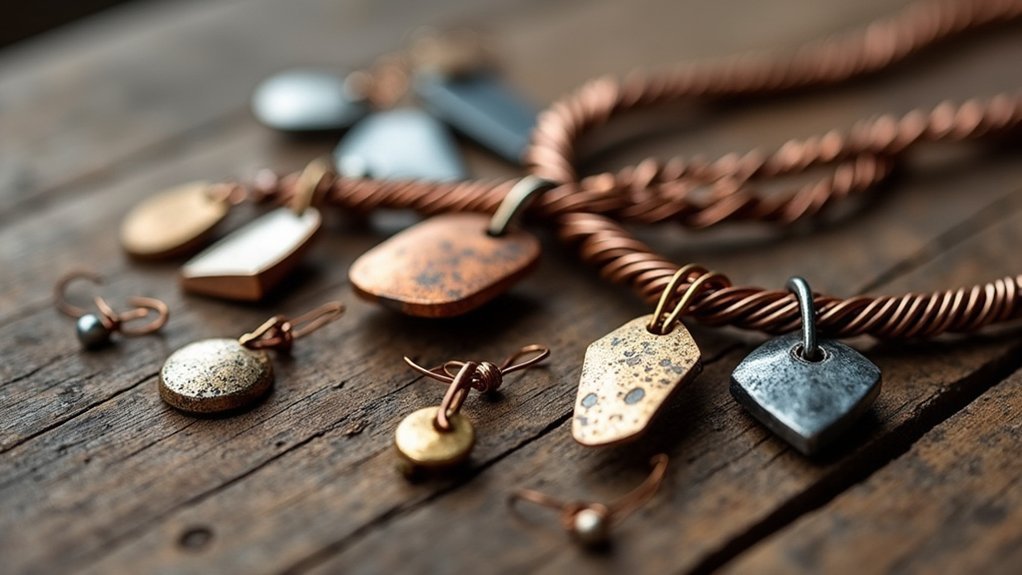
Understanding these environmental advantages naturally leads to exploring which specific metals work best for your sustainable jewelry projects.
You’ll find four excellent recycled metals that deliver exceptional results for eco-friendly jewelry creation.
Gold and silver offer premium options, sourced from old coins, jewelry scraps, and electronics. These precious metals maintain their quality and value while supporting your upcycling goals.
Copper provides warm color and excellent malleability, perfect for creative designs using plumbing scraps, electrical wires, and old tools.
Aluminum stands out for lightweight, corrosion-resistant properties. You can transform beverage cans and packaging into innovative pieces without sacrificing durability.
Each metal brings unique aesthetics and working properties to your jewelry making projects, allowing you to create distinctive pieces while supporting ethical, sustainable practices.
Sourcing Quality Scrap Metal for Your Jewelry Designs
You’ll need to identify trustworthy sources for scrap metal, from local recycling centers and junkyards to artisan workshops with leftover materials.
Once you’ve located potential suppliers, you must evaluate the metal’s quality by checking for impurities, toxic coatings, and overall condition before purchasing.
Don’t forget to research safety protocols and legal requirements in your area, as handling certain metals requires proper precautions and some materials may have sourcing restrictions.
Finding Reliable Metal Sources
Where can you find quality scrap metal that transforms everyday discarded items into stunning, eco-friendly jewelry pieces? Start by exploring local recycling centers, junkyards, and online marketplaces where individuals sell unwanted metal items.
These reliable sources offer diverse selections perfect for jewelry making projects. Focus on recyclable metals like old coins, broken jewelry, and discarded appliances, particularly gold and silver pieces that provide exceptional value and aesthetic appeal.
Build relationships with local artisans and businesses generating metal waste—they’ll provide consistent quality scrap supplies. Always verify metal purity and quality before purchasing, as impurities affect your final product’s appearance and durability.
Remember to prioritize safety by wearing protective gear like gloves and goggles when handling recycled metal materials during your crafting process.
Quality Assessment Techniques
Before you invest in scrap metal for jewelry making, you’ll need to master essential assessment techniques that separate high-quality materials from worthless scraps.
Start by checking for purity markings and certifications on recycled metal, especially gold and silver pieces that should display clear karat stamps. Conduct a density test to determine metal quality – higher density typically indicates superior materials perfect for lasting jewelry pieces.
Inspect for corrosion, rust, or excessive wear that could compromise your designs.
Source from reputable recycling centers that provide documentation about metal origin and processing for ethical sourcing compliance.
Learn to identify common scrap metal types like copper, aluminum, and brass, as each offers unique properties.
This systematic quality assessment approach guarantees you’ll create beautiful, durable jewelry while maintaining responsible sourcing standards.
Safety and Legal Considerations
While quality assessment protects your investment in materials, safety protocols protect you during the sourcing and handling process. Always wear safety gear, including gloves and goggles, when handling scrap metal to protect against sharp edges and potential chemical exposure.
Source materials from reputable recycling centers to avoid contamination with hazardous substances like lead or cadmium. Familiarize yourself with local regulations regarding scrap metal sourcing and ownership. Some materials require proof of ownership to avoid legal complications.
Consider obtaining certifications for recycled metals to demonstrate ethical sourcing practices to your customers. This documentation assures buyers of your materials’ sustainability and legitimacy.
Proper safety measures and regulatory compliance protect both your health and business reputation while supporting responsible jewelry making.
Essential Tools and Safety Equipment for Metal Recycling
You’ll need specific hand tools like pliers, wire cutters, and jewelers’ saws to effectively shape and manipulate your recycled metal materials.
Safety gear including protective gloves and goggles isn’t optional—it’s crucial for preventing injuries from sharp edges and metal debris.
Your workspace setup matters too, requiring specialized equipment like vices and proper lighting to guarantee both precision and safety throughout your metal recycling projects.
Basic Hand Tool Requirements
When setting up your metal recycling workspace for jewelry making, you’ll need specific hand tools that can handle the unique challenges of working with reclaimed materials.
Essential pliers and wire cutters are your primary tools for shaping recycled metal into desired forms. A jeweler’s saw allows you to cut precise sections for individual jewelry pieces.
You’ll also need files and sandpaper to smooth rough edges and remove imperfections from salvaged materials. A drill with various drill bits creates holes for threading and assembly.
Don’t forget safety equipment – protective gloves and goggles are non-negotiable when handling sharp metal fragments.
These basic tools form the foundation of your metal recycling toolkit, enabling you to transform scrap into stunning handcrafted jewelry safely and efficiently.
Critical Safety Gear
Building on your basic tool foundation, safety gear forms the protective barrier between you and potential hazards in metal recycling work.
You’ll need gloves to shield your hands from sharp edges and cuts while handling scrap materials. Safety goggles are essential for protecting your eyes from flying debris during cutting or grinding operations. Steel-toed boots prevent foot injuries when heavy metal pieces accidentally drop.
A dust mask or respirator filters harmful particles and fumes that emerge from certain metals or welding processes. Ear protection like earplugs or earmuffs prevents hearing damage from prolonged exposure to loud machinery.
Keep a first aid kit accessible on-site to address minor injuries promptly and maintain a safe working environment throughout your jewelry-making process.
Metal-Specific Equipment Needs
Different metals demand specialized equipment beyond your standard toolkit, making material identification your first priority.
Copper requires softer wire cutters to prevent work hardening, while aluminum needs sharper jewelers’ saws due to its tendency to clog blades. When working with recycled metal wire, you’ll need tension-adjustable pliers that won’t leave marks on softer metals like silver.
Your sturdy workbench becomes even more critical with varying metal hardnesses – harder metals require additional support to prevent vibration during cutting.
Metal-specific equipment includes different drill bit materials: high-speed steel for soft metals, cobalt for harder alloys. Your safety equipment must also adapt – thicker gloves for sharper aluminum edges, specialized goggles for flying particles from harder metals.
Tools for jewelry making should match your chosen metal’s properties for best results.
Cleaning and Preparing Recycled Metals for Jewelry Use
Before you can transform recycled metals into stunning jewelry pieces, you’ll need to thoroughly clean and prepare these materials to guarantee professional-quality results.
Proper preparation guarantees better bonding and a flawless finish for your jewelry making projects.
Start your cleaning process with these essential steps:
- Soak in warm soapy water – Use mild soap and scrub gently with a soft brush to remove dirt and grease
- Rinse thoroughly – Clean water removes all soap residue and prevents contamination
- Remove tarnish effectively – Apply vinegar solution or citric acid to restore shine on silver and other metals
- Dry completely – Prevent oxidation by making sure all moisture is eliminated before working
For the best results when preparing recycled metals, consider investing in an ultrasonic cleaner. This equipment removes stubborn grime without harsh chemicals.
Basic Techniques for Working With Reclaimed Gold and Silver
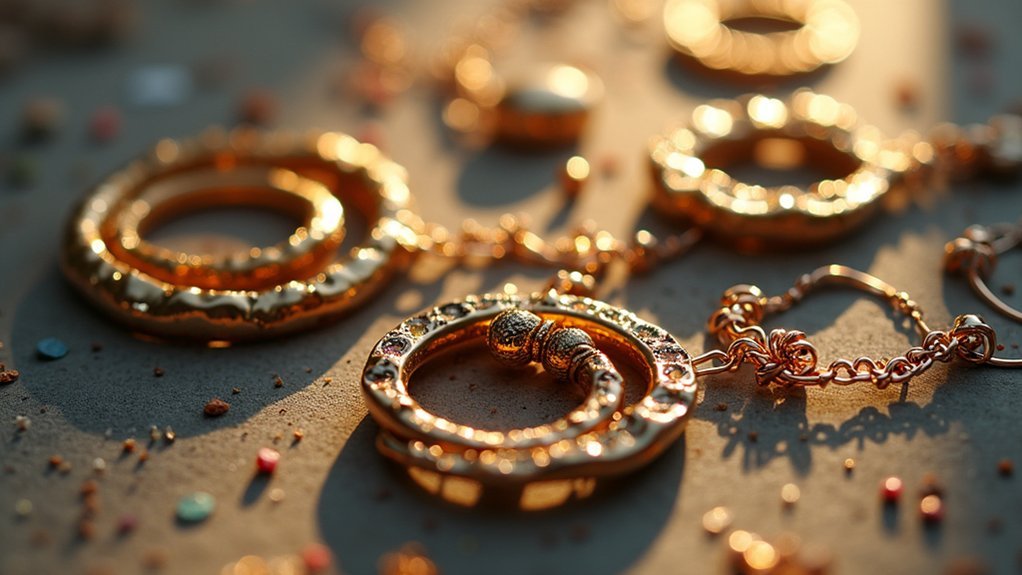
Working with reclaimed gold and silver requires mastering several fundamental techniques that’ll transform your recycled materials into professional-quality jewelry pieces.
Start by sourcing certified recycled metals like Fairmined to support ethical practices and a sustainable future.
Soldering becomes essential for creating beautiful seamless joins—you’ll need a torch and metal-specific solder for strong connections.
A jeweler’s saw gives you precision when cutting shapes from metal sheets, expanding your design possibilities considerably.
Wire wrapping adds intricate textures and details without requiring extensive equipment, perfect for creating beautiful pieces with minimal tools.
Remember that jewelry made from recycled metals requires regular cleaning with soft cloths and mild soap solutions to maintain their shine and prevent tarnishing over time.
Advanced Methods for Transforming Scrap Into Stunning Pieces
You’ll need to master complex welding techniques like TIG and MIG welding to join different scrap metals seamlessly and create intricate structural elements in your jewelry designs.
These advanced methods allow you to build layered compositions and achieve precise control over heat distribution, preventing damage to delicate reclaimed materials.
Professional finishing methods such as electropolishing, tumbling, and specialized patina treatments will transform your welded pieces into museum-quality jewelry that rivals traditionally manufactured pieces.
Complex Welding Techniques
When transforming scrap metals into exquisite jewelry pieces, complex welding techniques offer unmatched precision and creative freedom that basic joining methods simply can’t deliver.
TIG welding provides the accuracy you need for intricate designs, creating strong, durable connections in recycled metals. You’ll achieve professional-quality results while preserving the integrity of your materials through proper heat control and filler selection.
Key advantages of advanced welding in jewelry fabrication include:
- Precision joining – TIG welding enables detailed work on delicate components
- Material versatility – Fuse dissimilar metals like stainless steel with brass accents
- Enhanced efficiency – MIG welding speeds up assembly of thin metal sheets
- Professional durability – Advanced methods guarantee long-lasting structural integrity
Always prioritize safety equipment including welding gloves, helmets, and protective clothing during complex procedures.
Professional Finishing Methods
After mastering the structural foundation through advanced welding, professional finishing methods transform your raw welded pieces into museum-quality jewelry that rivals commercially manufactured items.
Polishing with buffing wheels and specialized compounds creates mirror-like surfaces that showcase your recycled metal’s inherent beauty. You’ll enhance depth through patina application, using chemical solutions to develop unique colors and textures that highlight your material’s character.
Laser engraving adds precision-crafted patterns and personalization, enabling intricate designs impossible with traditional tools. Advanced soldering techniques using micro torches guarantee secure connections while preserving your recycled material’s integrity.
Electroforming builds metal layers onto non-metal cores, creating lightweight yet complex structures that maximize your scrap’s aesthetic potential and market value.
Design Inspiration: Creative Projects Using Recycled Metals
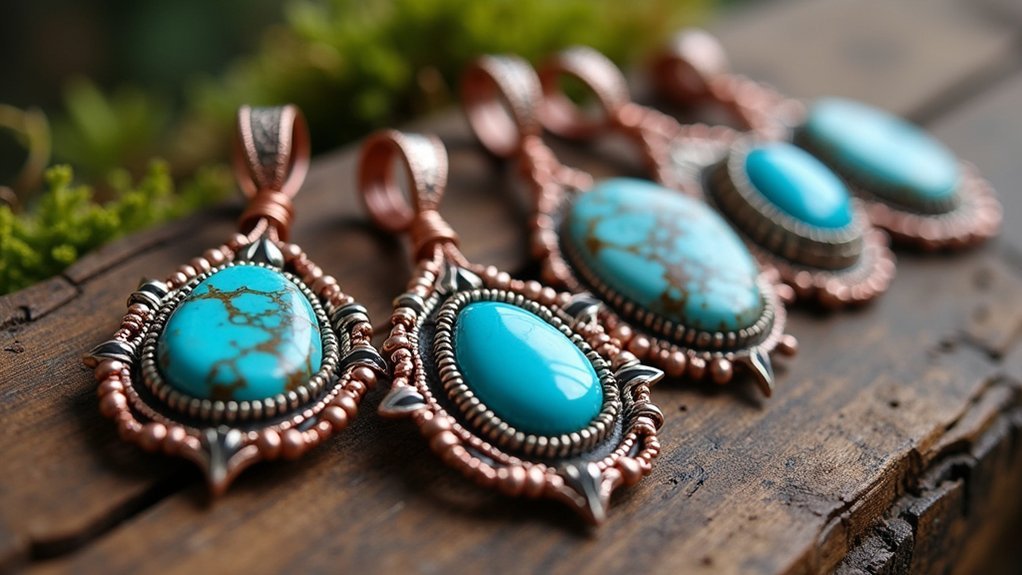
Because recycled metals offer endless creative possibilities, you can transform everyday discarded items into stunning works of art that make powerful environmental statements.
Creating sustainable jewelry from recycled materials lets you develop new skills while adding a unique touch to your collection.
You’ll discover countless ways to repurpose scrap metals into beautiful accessories:
- Transform old license plates into eye-catching pendants and statement pieces
- Craft delicate earrings from discarded utensils and vintage tin components
- Design intricate bracelets using salvaged wire and metal fragments
- Create bold rings from repurposed industrial materials and hardware
Sourcing materials from recycling centers supports responsible waste management while providing endless inspiration.
These projects encourage experimentation with various techniques, helping you develop problem-solving abilities as you breathe new life into forgotten metals.
Quality Testing and Durability of Recycled Metal Jewelry
While creating beautiful jewelry from recycled metals offers environmental benefits, you’ll want to assure these pieces maintain the same quality and longevity as traditionally sourced materials. Quality testing assures recycled silver and other metals meet jewelry industry standards through rigorous certification processes like Fairmined verification.
| Metal Type | Vickers Hardness (HV) | Durability Features |
|---|---|---|
| 14K White Gold | 100-165 | Higher hardness than 18K |
| Recycled Silver | Variable | Excellent corrosion resistance |
Reputable jewelers use spectrometry to confirm metal composition and strength. Recycled metals undergo the same durability assessments as newly mined materials. When properly alloyed, recycled silver retains exceptional resilience and can last generations with proper care. Durable finishes like rhodium plating further enhance longevity by preventing tarnishing.
Caring for and Maintaining Your Eco-Friendly Jewelry
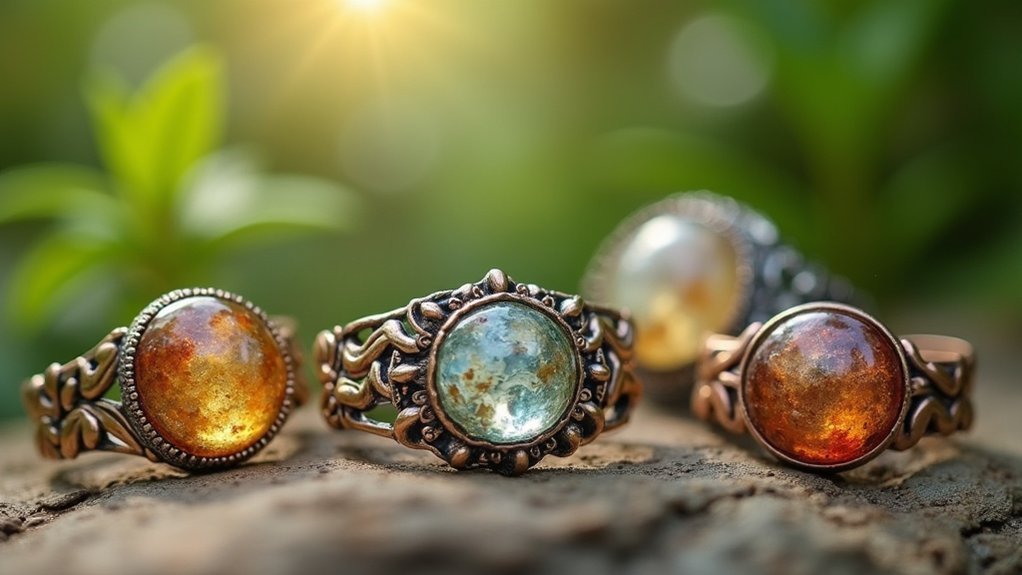
Now that you’ve invested in high-quality recycled metal jewelry, proper maintenance will preserve its beauty and extend its lifespan for decades.
Caring for eco-friendly metals requires attention to detail, but following simple practices guarantees your recycled silver and gold pieces continue to sparkle.
Essential maintenance steps include:
- Clean regularly with soft cloths and mild soap solutions to maintain its shine
- Store in cool, dry places using fabric-lined boxes or pouches
- Avoid harsh chemicals like cleaning agents and perfumes that damage finishes
- Address minor repairs promptly, including loose stones or broken clasps
Regular inspections help identify wear patterns early, allowing timely interventions.
This proactive approach to maintaining discarded metal transformations into beautiful jewelry helps maximize your investment while supporting sustainable practices.
Building a Sustainable Jewelry Making Practice
Creating your own sustainable jewelry-making practice transforms your creative passion into an environmentally responsible business that benefits both artisans and consumers.
Sustainable jewelry-making merges artistic creativity with environmental responsibility, creating meaningful benefits for makers and conscious consumers alike.
You’ll want to prioritize sourcing recycled metals like Fairmined silver and 100% recycled gold, which dramatically reduces environmental impact compared to traditional mining. Incorporate upcycled materials such as old skateboards or glass bottles to prevent waste while adding unique design elements to your jewelry pieces.
Adopt eco-friendly production methods through small-batch manufacturing and renewable energy sources to minimize your carbon footprint. Partner with local artisans for ethical sourcing that supports fair labor practices and preserves traditional craftsmanship.
When marketing your sustainable jewelry, educate consumers about recycled materials’ importance and use eco-friendly packaging that aligns with your environmental commitment.
Frequently Asked Questions
What Is the Most Sustainable Metal for Jewelry?
You’ll find recycled gold is the most sustainable jewelry metal choice. It requires 90% less energy than mining new gold and dramatically reduces greenhouse gas emissions while maintaining the same quality and beauty.
How Do You Make Jewelry Eco-Friendly?
You’ll make jewelry eco-friendly by using recycled metals, incorporating upcycled materials, sourcing ethical gemstones, adopting small-batch production methods, and choosing sustainable packaging that reduces your environmental impact.
Is Scrap Metal Recycling Environmentally Friendly?
You’ll find scrap metal recycling extremely environmentally friendly since it saves up to 95% energy compared to new metal production, reduces greenhouse gas emissions, prevents mining pollution, and diverts waste from landfills effectively.
Can You Make Jewelry From Recycled Materials?
You can absolutely make jewelry from recycled materials like reclaimed gold, silver, old coins, and vintage components. You’ll create unique pieces while reducing environmental impact and supporting sustainable practices in the jewelry industry.
In Summary
You’ve discovered how recycled metals can transform your jewelry making into an eco-conscious art form. By choosing scrap materials over newly mined metals, you’re reducing environmental damage while creating unique pieces with incredible stories. Your commitment to sustainable practices doesn’t just benefit the planet—it sets you apart as a responsible artisan. Start sourcing quality recycled metals today and watch your creativity flourish while making a positive environmental impact.

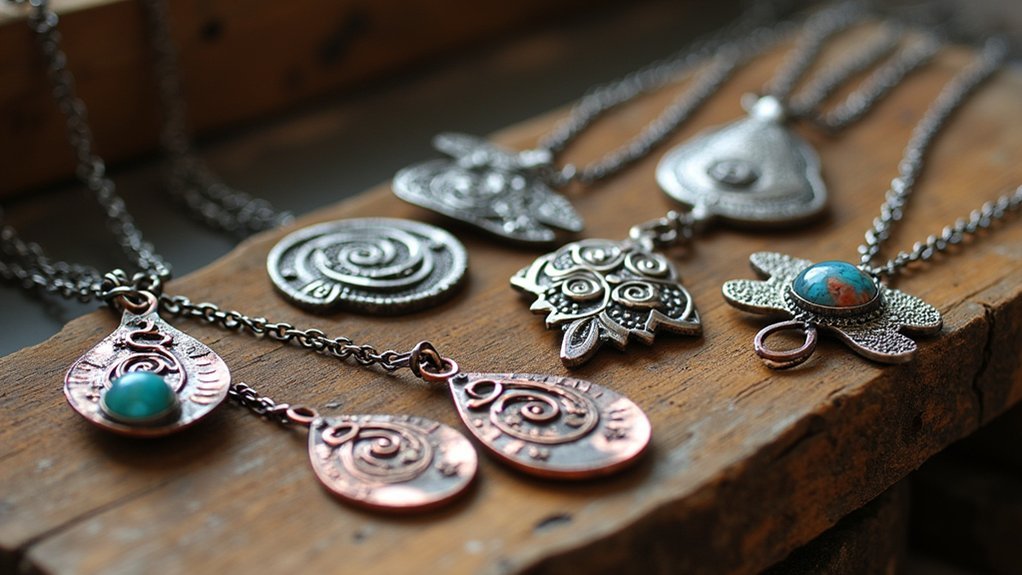



Leave a Reply